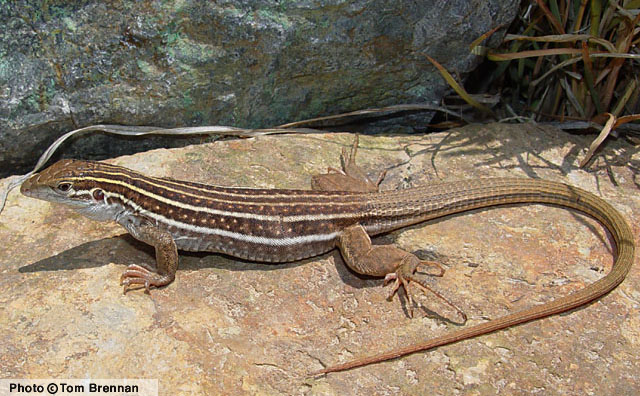Online Field Guide to The Reptiles and Amphibians of Arizona



Pima County, AZ
| SONORAN SPOTTED WHIPTAIL Aspidoscelis sonorae | |
|
DESCRIPTION: A small to medium-sized (up to 89 mm or 3.5″ from snout to vent), slim, brown to black lizard with a long, thin tail, and a slim, pointed snout. The body is marked with six yellow to cream stripes and relatively few light spots. There area between the two central dorsal stripes usually lacks spots. The tail is olive to brown. The underside is plain and pale. Juveniles lack spots. The scales on the body are small and granular. The scales on the tail are large, keeled, and rectangular. The belly scales are large, smooth, and rectangular. The scales on top of the head are large, smooth, and plate-like. The Sonoran Spotted Whiptail’s distinct stripes (particularly on the neck) and relatively spare spotting distinguish it from the similar looking Chihuahuan Spotted Whiptail. Its olive-brown tail and lack of spots between the two central dorsal stripes distinguish the Sonoran Spotted Whiptail from the similar looking Canyon Spotted Whiptail. HABITAT: Inhabits communities ranging from Semidesert Grassland, through Madrean Evergreen Woodland, to Petran Montane Conifer Forest. It also follows riparian corridors down into Chihuahuan Desertscrub and Arizona Upland Sonoran Desertscrub in some areas. Found in a variety of terrain types including steep rugged canyons, rolling wooded hills, and relatively flat, open, low valleys. Often encountered along drainages and riparian corridors. BEHAVIOR: This is an alert, diurnal, fast-moving ground-dweller. It is often encountered foraging or basking in the mid-morning sun. Adults often go into hibernation in late summer. Juveniles remain active until fall. Both adults and juveniles emerge from hibernation in spring. DIET: It actively forages by rooting around in organic matter under bushes and by digging in the soil around the bases of rocks and other surface debris. It feeds on termites, spiders, beetles, ants, grasshoppers, and other invertebrates. REPRODUCTION: All Sonoran Spotted Whiptails are female (parthenogenetic). Eggs are unfertilized and hatchlings are clones of the mother. Clutches of 1 to 7 eggs are laid in late spring or summer. Hatchlings begin to appear in late July. By Thomas C. Brennan Brennan, T. C., & A. T. Holycross. 2006. A Field Guide to Amphibians and Reptiles in Arizona. Arizona Game and Fish Department. Phoenix, AZ Degenhardt, W. G., Painter, C. W., and Price, A. H.. 1996. Amphibians and Reptiles of New Mexico. University of New Mexico Press. Albuquerque. Lazaroff, D. W., P. C. Rosen, and C. H. Lowe. 2006. Amphibians, Reptiles, and Their Habitats at Sabino Canyon. University of Arizona Press. Tucson, AZ Stebbins, R.C. 2003. A Field Guide to Western Reptiles and Amphibians, Third Edition. Houghton Mifflin Company, Boston, MA. |
|
Visit Partners in Amphibian and Reptile Conservation:


HOME
Copyright © 2023, Arizona Game and Fish Department. All rights reserved.
If you make use of the textual contents of this site in reports, publications, etc. please cite and credit the author(s) and photographer(s). All photos on this website are copyrighted. However, those found in the species account section may be used for any noncommercial scientific, educational, or conservation purposes provided that photographs are not altered and continue to bear the copyright symbol and name of the photographer. Please contact the photographer regarding commercial use of copyrighted photographs.










